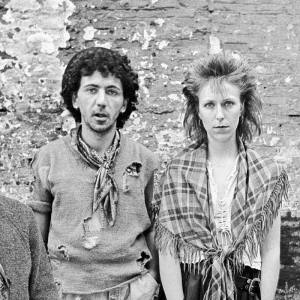Since the dawn of the Grateful Dead, there has been certain imagery that has escaped from the band’s music and found its way into the very fabric of Dead culture. Almost like a language universal to all Deadheads, these images are as integral to the fandom as the music. But what do they mean?
Videos by American Songwriter
[RELATED: 5 Grateful Dead Deep Cuts You Should Be Listening To]
Below is a quick guide to the Grateful Dead’s iconography.
1. The 13-Point Lightning Bolt
The 13-Point Lightning Bolt is a significant visual in the world of the Dead. It was designed by the band’s engineer, Owsley “Bear” Stanley, with artist Bob Thomas as a way to mark the band’s equipment and make it easier to keep up with while they were touring festivals.
“The Dead in those days had to play in a lot of festival-style shows where the equipment would all wind up at the back of the stage in a muddle,” Stanley explained of the icon’s origins. “Since every band used pretty much the same type of gear it all looked alike. We would spend a fair amount of time moving the pieces around so that we could read the name on the boxes. I decided that we needed some sort of marking that we could identify from a distance.”
2. The Skeletons
Where there’s the Dead, there are bones. The skeleton motif is a reoccurring one throughout the Dead’s iconography. There’s the famed skeleton crowned in roses on their 1971 self-titled album, and there’s the skeleton dressed as a jester wielding a lute that brandishes the cover of The Grateful Dead Songbook. The iconic Uncle Sam skeleton, a reference to their song “U.S. Blues,” will rear his head from time to time, as well.
3. The Steal Your Face Skull
Probably the most recognizable Dead imagery is the Steal Your Face skull, or Stealie. The large-domed red, white, and blue skull combines the band’s signature lightning bolt, which strikes through Stealie’s cranium, and the group’s penchant for boney visages. The image takes its name from the 1976 album on which it appears.
4. The “Dancing” Bears
An icon a little less ghoulish, but just as recognizable, are the “Dancing” Bears. The colorful shaggy bears—most often presented in a row, a kickline of sorts—are not actually dancing, but instead marching.
The bears were another design from artist Bob Thomas, and inspired by the band’s aforementioned engineer Stanley, who took on the nickname “Bear.” The “dancing” bear image first appeared on the back cover of the band’s 1973 live album, History of the Grateful Dead, Volume One, known simply as Bear’s Choice.
“I don’t know why people think they are, their positions are quite obviously those of a high-stepping march,” Stanley said of the design. “You can also see what some people think are ‘bibs,’ are actually a stylization of the chest fur of the bear.”
5. The Terrapins
Another recognizable Dead emblem is of two turtles or terrapins, one playing the banjo, the other rattling a tambourine. The image is taken from the cover of the band’s 1977 album, Terrapin Station. Unlike the bears, the terrapin pair are dancing, tearing it up on the platform of a railway station.
Photo by Kirk West/Getty Images
